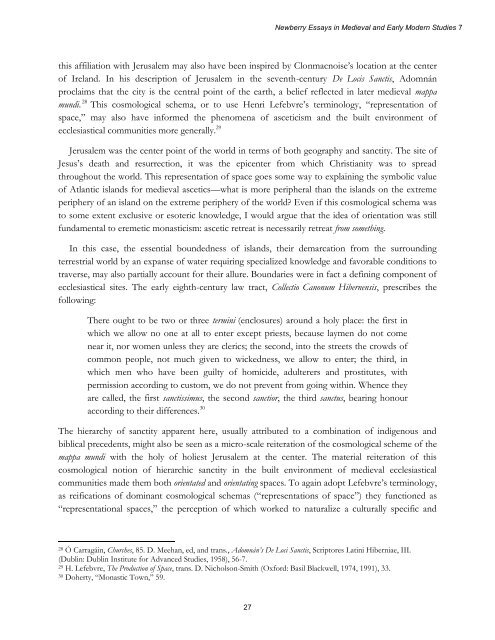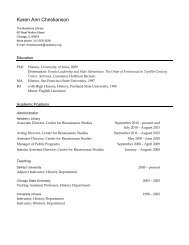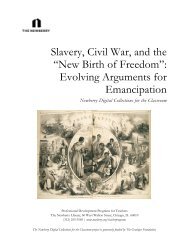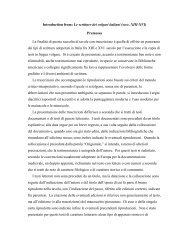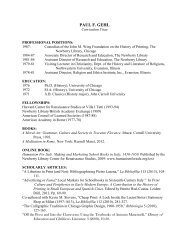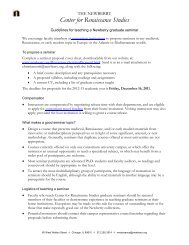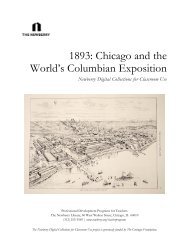Newberry Essays in Medieval and Early Modern ... - Newberry Library
Newberry Essays in Medieval and Early Modern ... - Newberry Library
Newberry Essays in Medieval and Early Modern ... - Newberry Library
Create successful ePaper yourself
Turn your PDF publications into a flip-book with our unique Google optimized e-Paper software.
<strong>Newberry</strong> <strong>Essays</strong> <strong>in</strong> <strong>Medieval</strong> <strong>and</strong> <strong>Early</strong> <strong>Modern</strong> Studies 7this affiliation with Jerusalem may also have been <strong>in</strong>spired by Clonmacnoise’s location at the centerof Irel<strong>and</strong>. In his description of Jerusalem <strong>in</strong> the seventh-century De Locis Sanctis, Adomnánproclaims that the city is the central po<strong>in</strong>t of the earth, a belief reflected <strong>in</strong> later medieval mappamundi. 28 This cosmological schema, or to use Henri Lefebvre’s term<strong>in</strong>ology, “representation ofspace,” may also have <strong>in</strong>formed the phenomena of asceticism <strong>and</strong> the built environment ofecclesiastical communities more generally. 29Jerusalem was the center po<strong>in</strong>t of the world <strong>in</strong> terms of both geography <strong>and</strong> sanctity. The site ofJesus’s death <strong>and</strong> resurrection, it was the epicenter from which Christianity was to spreadthroughout the world. This representation of space goes some way to expla<strong>in</strong><strong>in</strong>g the symbolic valueof Atlantic isl<strong>and</strong>s for medieval ascetics—what is more peripheral than the isl<strong>and</strong>s on the extremeperiphery of an isl<strong>and</strong> on the extreme periphery of the world? Even if this cosmological schema wasto some extent exclusive or esoteric knowledge, I would argue that the idea of orientation was stillfundamental to eremetic monasticism: ascetic retreat is necessarily retreat from someth<strong>in</strong>g.In this case, the essential boundedness of isl<strong>and</strong>s, their demarcation from the surround<strong>in</strong>gterrestrial world by an expanse of water requir<strong>in</strong>g specialized knowledge <strong>and</strong> favorable conditions totraverse, may also partially account for their allure. Boundaries were <strong>in</strong> fact a def<strong>in</strong><strong>in</strong>g component ofecclesiastical sites. The early eighth-century law tract, Collectio Canonum Hibernensis, prescribes thefollow<strong>in</strong>g:There ought to be two or three term<strong>in</strong>i (enclosures) around a holy place: the first <strong>in</strong>which we allow no one at all to enter except priests, because laymen do not comenear it, nor women unless they are clerics; the second, <strong>in</strong>to the streets the crowds ofcommon people, not much given to wickedness, we allow to enter; the third, <strong>in</strong>which men who have been guilty of homicide, adulterers <strong>and</strong> prostitutes, withpermission accord<strong>in</strong>g to custom, we do not prevent from go<strong>in</strong>g with<strong>in</strong>. Whence theyare called, the first sanctissimus, the second sanctior, the third sanctus, bear<strong>in</strong>g honouraccord<strong>in</strong>g to their differences. 30The hierarchy of sanctity apparent here, usually attributed to a comb<strong>in</strong>ation of <strong>in</strong>digenous <strong>and</strong>biblical precedents, might also be seen as a micro-scale reiteration of the cosmological scheme of themappa mundi with the holy of holiest Jerusalem at the center. The material reiteration of thiscosmological notion of hierarchic sanctity <strong>in</strong> the built environment of medieval ecclesiasticalcommunities made them both orientated <strong>and</strong> orientat<strong>in</strong>g spaces. To aga<strong>in</strong> adopt Lefebvre’s term<strong>in</strong>ology,as reifications of dom<strong>in</strong>ant cosmological schemas (“representations of space”) they functioned as“representational spaces,” the perception of which worked to naturalize a culturally specific <strong>and</strong>28 Ó Carragá<strong>in</strong>, Churches, 85. D. Meehan, ed, <strong>and</strong> trans., Adomnán’s De Loci Sanctis, Scriptores Lat<strong>in</strong>i Hiberniae, III.(Dubl<strong>in</strong>: Dubl<strong>in</strong> Institute for Advanced Studies, 1958), 56-7.29 H. Lefebvre, The Production of Space, trans. D. Nicholson-Smith (Oxford: Basil Blackwell, 1974, 1991), 33.30 Doherty, “Monastic Town,” 59.27


